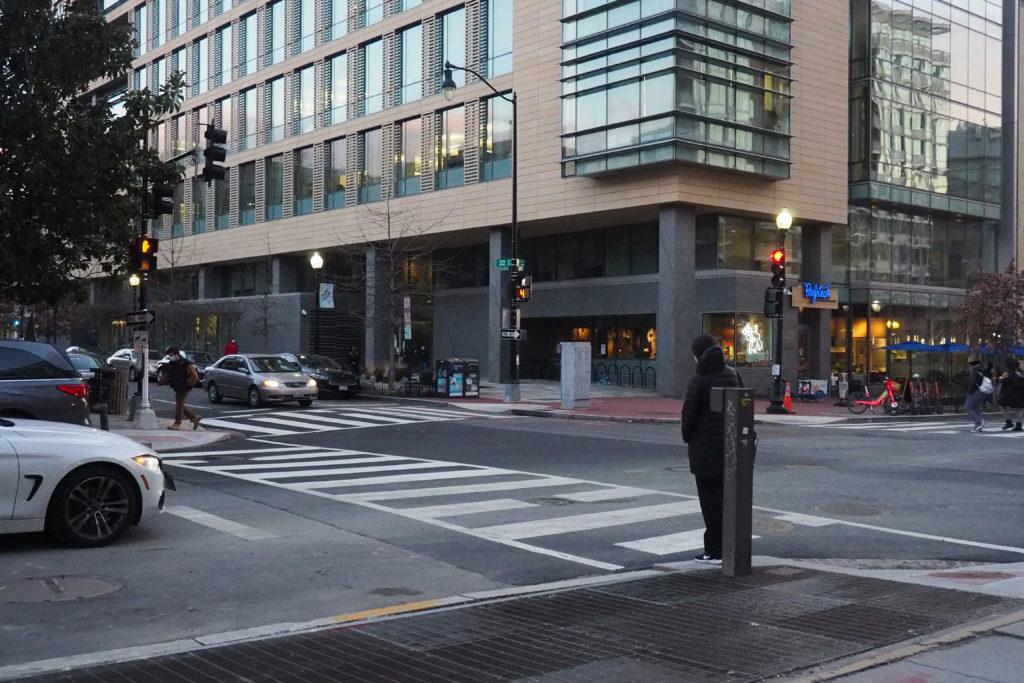Construction at the intersection at the corner of 22nd and I streets officially wrapped up Thursday, unveiling a newly installed crossing system to enhance accessibility and pedestrian safety in the area.
James Harnett, an alumnus and the former chair of the Foggy Bottom and West End Advisory Neighborhood Commission, said District Department of Transportation officials painted a new crosswalk, which had been previously missing on the east side of the intersection near the Medical Faculty Associates building and constructed sidewalk curb dips that descend to the street. He said the improvements also include traffic light timer corrections and spoken audio for cross signals.
Harnett said the upgrades help fill several holes in accessibility standards, where nearby signs had previously instructed pedestrians not to cross I Street without a crosswalk, which he said violates a D.C. law that allows pedestrians to cross the street at any intersection in the District. Without a crosswalk and sidewalk dips in years past, people with physical disabilities, like those requiring wheelchairs, struggled to enter the ambulatory care center housed in the MFA building, he added.
Harnett said the intersection’s improvements, which are privately funded by real estate company Boston Properties, should have been fixed by the D.C. government “a long, long time ago.”
“We as policymakers, we as engineers, we as a city government have a responsibility to keep people safe, and when we don’t make the sort of investments we need to to keep people safe, we’re not serving our community,” Harnett said.
Harnett said the new improvements now make the area accessible under the Americans with Disabilities Act, since individuals in wheelchairs can use the curb dips to move between the sidewalk and crosswalk and the crossing audio will accommodate people with hearing disabilities. He said the renovations also repair traffic lights that sometimes took extra time to turn green while the crossing signals told pedestrians to wait, which delayed traffic movement at stop lights.
“When we have a system where the the intersection design makes that kind of activity unsafe, it’s not the pedestrian’s fault, it’s not the driver’s fault, it’s the engineers that design that intersection,” Harnett said.
Harnett said “emergency egress grates” that have occupied the southeastern corner of the intersection have been the reason why the area hadn’t included a fourth crosswalk as officials couldn’t block the grates designed as an escape hatch. He said students have still frequently crossed the road without a crosswalk, so stakeholders partnered with the Washington Metropolitan Area Transit Authority, which owns the grates, to negotiate building a crosswalk and sidewalk dips nearby.
“It took a unique and uncommon partnership with WMATA to get them to say that they would work with us on designing both accessible pedestrian dips into the roadway so that folks on walkers or wheelchairs or with canes or other mobility devices can safely get into the roadway,” Harnett said.
The intersection’s renovation comes as one of several neighborhood improvement projects that Boston Properties is managing as part of its community agreement to reconstruct 2100 Pennsylvania Avenue and Rice Hall into a new 2100 Penn facility. Boston Properties launched another construction project earlier this fall at Reservation 28, one of the parks across the street from The Shops at 2000 Penn, under the terms of the 2100 Penn deal.
Harnett said the ANC voted in 2017 to include the area as one of the real estate company’s construction projects, and Boston Properties started finalizing plans to advance official planning for construction two years ago.
Harnett said construction at the intersection started in late July, but the majority of the process was delayed until November because the intersection’s foundation and infrastructure didn’t match with the designs provided by D.C. Water, the city’s water utility. Officials with Boston Properties “had to go back to the drawing board” to ensure D.C. Water would authorize the road work, which pushed construction deeper into the fall.
Harnett said he hopes the intersection’s revamped accessibility will help protect pedestrians, especially those with disabilities, as traffic fatalities have trended upwards over the past six years. The District saw 36 traffic fatalities in 2020, tied for the most during that six-year stretch of time.
“The government should just should be able to identify and fix problems before people start dying, and we’ve seen as a result of this year and of frankly the years of traffic deaths and deaths of spiteful bicyclists and other people on the road that our government has not done enough to solve those problems,” Harnett said.







